Outstanding images of Santa Águeda in Navarre
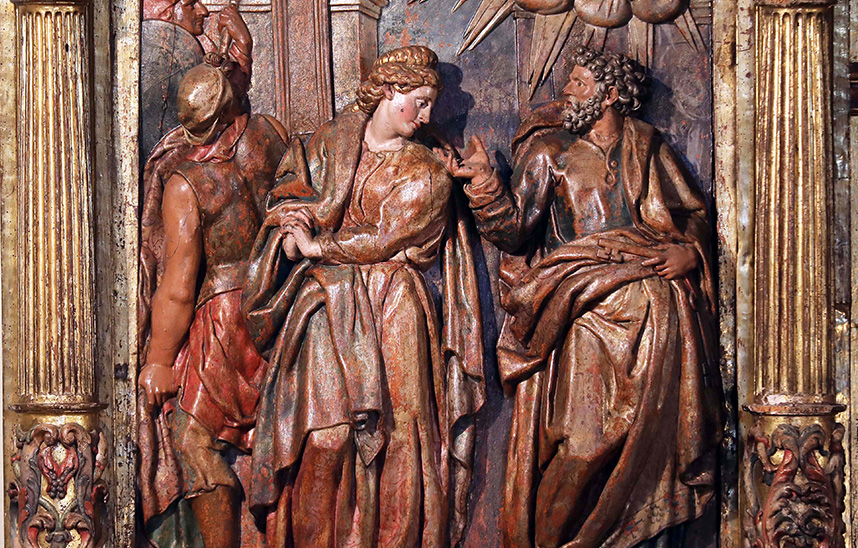
PhotoJ. A. Goñi. Diario de Navarra/Relief of the visit of St. Peter to St. Agatha in prison, from the main altarpiece of Aizoáin, work of Martín de Elordi and Pedro Moret, valued in 1597.
The cult of some martyrs such as St. Lucy or St. Agatha enjoyed great popularity in the past. St. Agatha possessed, in the eyes of traditional society, everything a young woman could desire: position, distinguished family, extraordinary beauty and faith in Jesus Christ. This was demonstrated when the proconsul of Sicily, Quintianus, "libidinous, avaricious and idolatrous", according to the hagiographies of the saint, took advantage of the persecution of the emperor Decius (250-253) against the Christians to try to possess her. His proposals were decisively rejected by the young virgin, because she was engaged to her husband Jesus Christ. The tyrant did not give up and delivered her into the hands of Aphrodisia, a perverse woman, who ran a brothel with her ten daughters, with the idea that she would bend her to the temptations of the world. Her evil arts were contradicted by the virtue and fidelity to Christ that the young woman witnessed. Quintiano, then, dominated by anger, tortured her cruelly, to the point of ordering her breasts to be cut off. On that occasion, he received a famous reply from Agatha: "Cruel tyrant, are you not ashamed to torture in a woman the same breast with which you nourished yourself as a child?The saint was consoled by a vision of St. Peter who miraculously healed her. But the tortures continued and she finally deserved the palm of martyrdom, being thrown over burning coals in Catania.
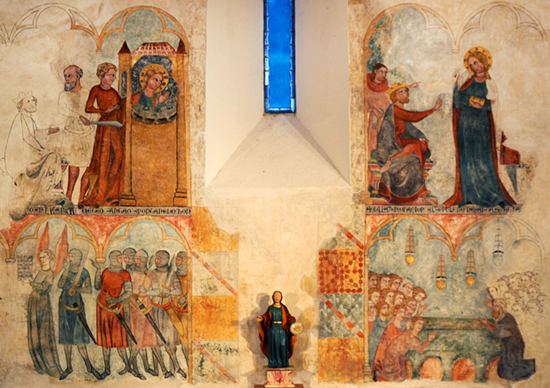
Mural paintings of Olloqui with the cycle of Saint Agatha, by the circle of Juan Oliver, second quarter of the 14th century. Photo C. Martínez Álava
In Navarra there are two parishes (Idoate and Aizoain) and twenty-three hermitages. This last data is significant within the issue of that subject of sanctuaries dedicated to saints: Saint Lucia has 54 hermitages, Saint Barbara, 45; Mary Magdalene, 24; Saint Agatha, 23; and Saint Catherine and Saint Engracia, 22. She is venerated as a special advocate against chest pain and against fire and in her feast the ringing of bells, choirs and cuestaciones have had great importance.
Her feast day is commemorated with solemnity in some towns such as Legarda. Cáseda celebrates her as patron saint with bells, procession, fireworks, music and the participation of the town council in the religious acts.
Iconography
Of enormous expressiveness is the scene of her martyrdom illustrated in the copy of the bible of Sancho el Fuerte, preserved in Augsburg, a work from the end of the 12th century. In this codex, no less than six passages are dedicated to the saint, on three pages, which is the largest iconographic cycle of the martyr in Navarrese art. As is well known, the so-called Pamplona Bibles are two codices made by Ferrando Petri de Funes and his workshop, shortly before 1200, copies of which are preserved today in Amiens and Augsburg. It is in the latter copy that we find the greatest emphasis on the female saints, including some of the oldest narrative cycles of some of the saints in the West. In this regard, it should be remembered that the aforementioned codex must have been made for the sister of Sancho the Strong, Doña Berenguela, wife of Richard the Lionheart. The scene of the martyrdom of Saint Agatha also appears on the Romanesque doorway of San Miguel de Estella.
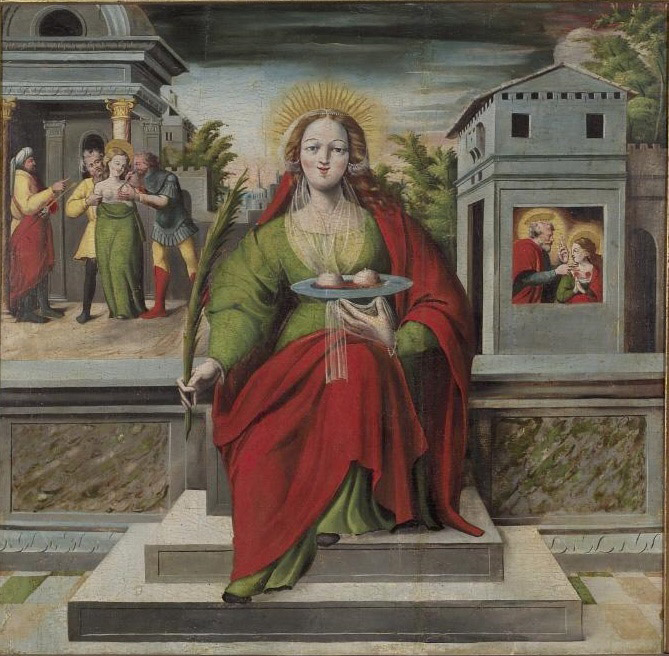
Tablet of Saint Agatha by Ramón de Oscáriz, c. 1570, from Sarriguren, in the Museum of Navarre.
A cycle, characterized by the narrativism typical of Gothic, is preserved in the frescoes of the parish church of Olloqui, related to the paintings of Ororbia, both works of great quality, made in the second quarter of the 14th century, in the circle of Juan Oliver, the author of the mural of the refectory of the cathedral of Pamplona, today in the Museum of Navarre. Four scenes make up the singular work studied by Carlos Martínez Álava and Javier Martínez de Aguirre. The set is of great importance both for the cycle, as for its authorship and its patron, the hospital canon Pedro de Olloqui of Pamplona between 1331 and 1357. Four passages are narrated in two registers, in the upper one the martyrdom (the saint before Quintiano, represented as a king and with Afrodisia) and in the lower one the burial and cult.
Another small cycle of his life can be found in the main altarpiece of the parish of Aizoáin, the work of Martín de Elordi and Pedro Moret, which was valued in 1597. However, the quality and energy of the sculpture of the altarpiece and particularly of some of its reliefs suggests one of the great sculptors of the time, higher than Elordi, who was the one who contracted the altarpiece, later associating the aforementioned Pedro Moret. As we know, it was internship usual to subcontract the sculpture or to look for a skilled master by the one who had been awarded the work. Good test is the complaint of Juan de Bazcardo, in 1605, against the aforementioned Elordi because he had collaborated in the execution of the Lerruz altarpiece.
In the main body of the Aizoain altarpiece, on both sides of the seated carving of the saint, we find two reliefs of the life of Saint Agatha. One narrates the martyrdom with the saint half-naked and the executioner grabbing her breast that he is about to cut with a large scissors, partially disappeared. Although the story is atrocious, there are other examples of the same in Navarre, such as the one in the parish of Mañeru, where the sadistic executioner's large tongs are used to cut the breasts of the virgin Agueda. The other scene of the Aizoáin altarpiece is centered on the visit of Saint Peter, identified by his keys, to cure the saint, closely following the conversation between the two, narrated in the Golden Legend, when Águeda does not allow herself to be cured out of modesty, until the prince of the apostles identifies himself as such.
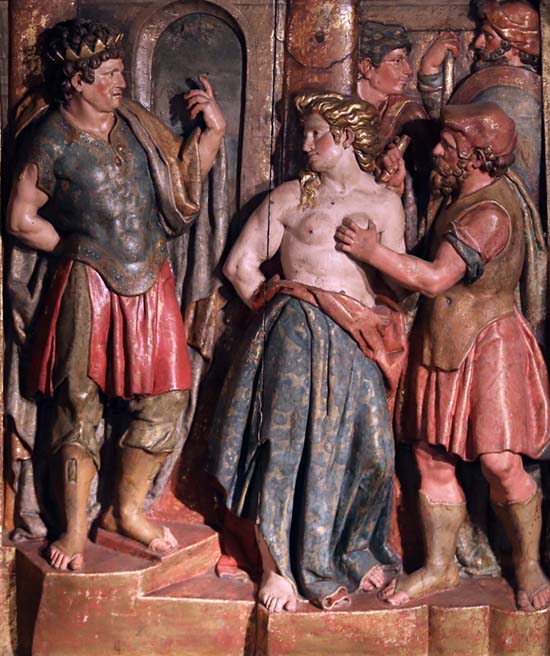
Relief of the martyrdom of Saint Agatha from the main altarpiece of Aizoáin, made by Martín de Elordi and Pedro Moret and appraised in 1597. Photo J. A. Goñi. Newspaper of Navarra
From the late Gothic period and throughout the 16th century and the beginning of the following century, she is usually represented paired with another martyr (Sangüesa, Cárcar...). In the altarpiece of the saints Juanes de Muruzábal, work of the beginning of the XVI century attributed to Diego Polo by A. Aceldegui, it is found with saint Catalina. In a panel by the master of Gallipienzo, identified by Pedro Echeverría as Pedro Sarasa, we see her with Saint Barbara; in the main altarpiece of Burlada (Museum of Navarra), with the Magdalena and in the main altarpiece of Etayo with Saint Ursula. Her identification is always easy because she carries her breasts, an attribute of her martyrdom, and the palm, which assures triumph and victory.
Its images corresponding to the first Renaissance and Romanesque periods are abundant throughout the region and are counted by more than a hundred. The sculpture of the Renaissance has such beautiful examples as those of Huarte-Araquil or Belascoain and the Romanesque plastic is very rich in its reliefs and images.
As far as painting is concerned, we must mention the panel of the saint from Sarriguren, which is preserved in the Museum of Navarre, the work of Ramón de Oscáriz (c. 1570), in which there are two scenes of martyrdom and the visit of St. Peter to cure him.
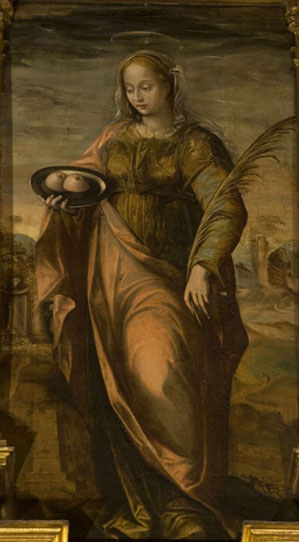
Saint Agatha in the main altarpiece of the monastery of Fitero, by Rolan Mois, 1590. Photo J. L. Larrión
Among the Mannerist paintings, the examples of Fitero and Cortes stand out for their quality. In the first case, a A panel of the main altarpiece of the monastery, a work contracted by Rolan Mois in 1590, shows the quality of a master who had been in Italy and knew the models of those lands, as well as the prints of Cornielis Cort and other engravers. The painting of Cortes, from the beginning of the 17th century, is the work of Juan de Lumbier and forms a pair with another of the same characteristics of Saint Lucia. The iridescent and vivid colors testify to the way of working of that painter, protagonist of Mannerism in the Ribera de Navarra. Also noteworthy are a panel from the parish of Milagro, made in 1619 by the painter Celedón Pérez -perhaps Celedonio Pérez del Castillo-, and a canvas from the middle of the 17th century, kept in the Carmelitas de Araceli de Corella. Baroque carvings are not so abundant and, in general, are not of great quality.
